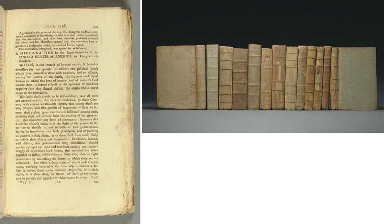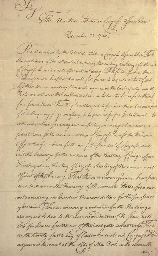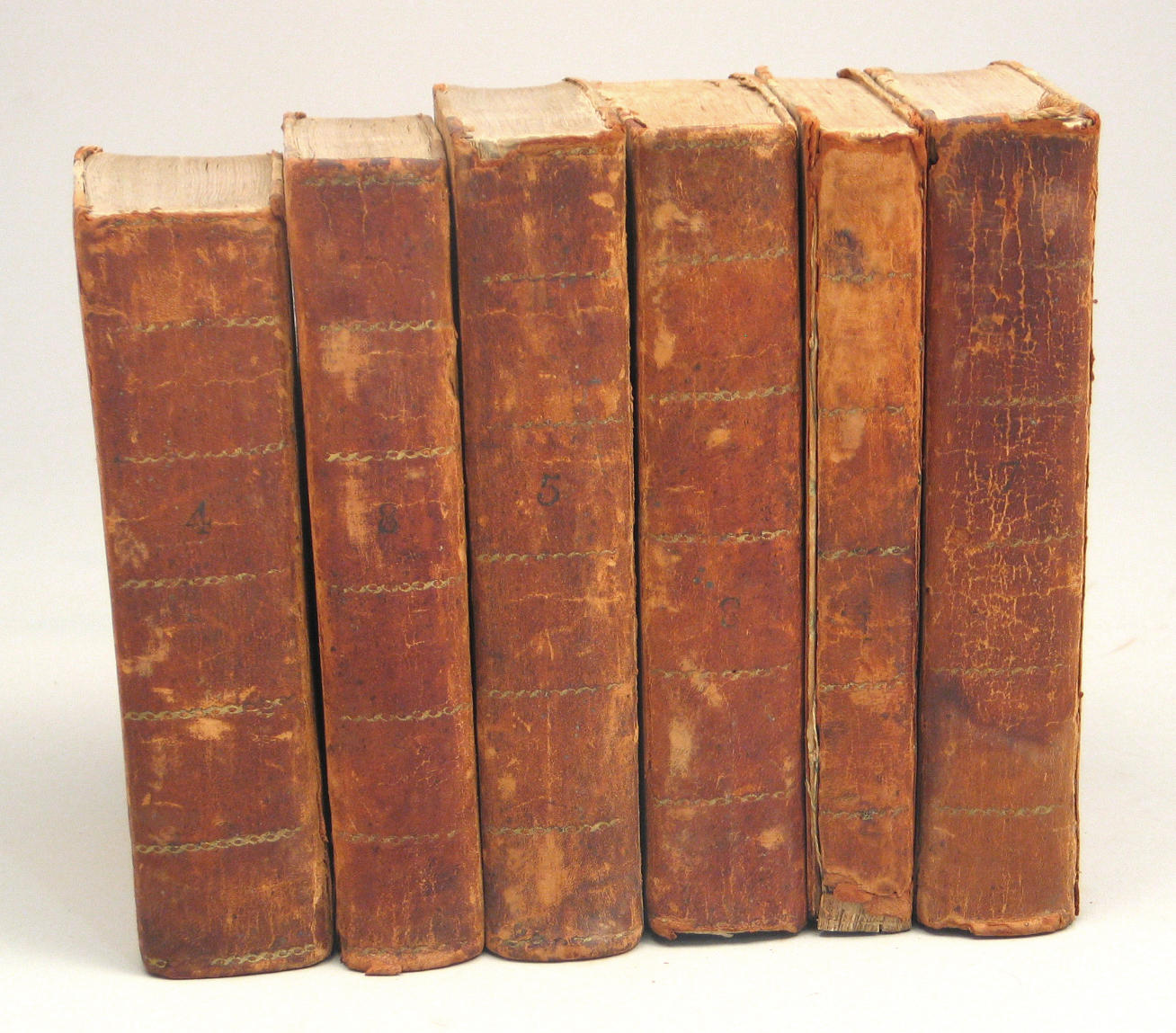UNITED STATES, CONTINENTAL CONGRESS]. FRANKLIN, Benjamin (1706-1790). Manuscript draft of a proposed plan for American government, entitled "Articles of Confederation and Perpetual Union entered into by the Delegates of the several Colonies of New Hampshire, &c in General Congress met at Philadelphia, May 10, 1775." [Philadelphia, ca.21 July 1775]. 8 pages, folio (watermark "Pro Patria, C.T. & Son") text in a bold contemporary hand, ink somewhat pale. Half red morocco gilt-lettered protective case. FRANKLIN'S PROPOSED ARTICLES OF CONFEDERATION: "THE NAME OF THIS CONFEDERACY SHALL HENCEFORTH BE THE UNITED COLONIES OF N. AMERICA...." Benjamin Franklin's first and very influential draft of what later became the instrument under which the United States was governed, however imperfectly, from March 1781 until the Federal government and new Constitution went into effect on 4 March 1789. The British crown had attemped to federate the New England colonies (see lot 1), as a means of asserting royal control. Since at least 1754 when he drafted the Albany Plan of Union, Franklin had envisioned some form of united league or compact to govern the separate and disparate American colonies. "Now, in 1775, Franklin put forth the idea again, but with one big difference: although his plan allowed for the possibility that the new confederation would remain part of the King's empire, it was designed to work even if the empire fell apart" (W. Isaacson, Benjamin Franklin An American Life , p.299). In fact, the plan he submitted--on his own volition--to his fellow delegates in the 2nd Continental Congress "contained the seeds of the great conceptual breakthrough that would eventually define America's federal system: a division of powers between a central government and those of the states. Franklin, however, was ahead of his time..." (Ibid.). The manuscript, originally part of the Sang Collection, has not previously been identified as Franklin's draft Articles of Confederation. It is entirely without a subscribed name or a docket which might indicate by whom or for whose use it was prepared. The date in the heading is the date the Second Continental Congress convened at Philadelphia, not the date of the manuscript itself. The draft embodies a number of mostly minor differences in text and punctuation from the version recorded in the Journals of Congress by Secretary Charles Thomson on 21 July 1775: "Agreeably to order the Congress resolved itself into a Committee of the Whole to take into consideration the State of America, when Doct. B. Franklin submitted to their consideration the following Sketch of Articles of Confederation." It was not until 11 June 1776--almost a year later--that a Congressional committee was created in the wake of R.H. Lee's motion for independence to formulate Articles of Confederation. Their version, owing much to Franklin's, was submitted by John Dickinson to Congress, which directed that 80 copies be printed and distributed. A final text, incorporating elements of both drafts, was approved by Congress on 15 November 1777 and submitted for unanimous ratification by the states, a process which required more than three years to complete. Franklin's is shorter than either Dickinson's or the 1781 version. Thomson's term, "sketch," is an apt one. Franklin's, Dickinson's and and the final 1781 version all contain 13 distinct articles. In his 1775 draft, Franklin employs the terms "colony" or "colonies" throughout; in Dickinson's both "colony" and "states" are employed, while in the 1781 Articles the compacting bodies are in all cases referred to as "states." Article 1 reads: "The name of this Confederacy shall henceforth be the United Colonies of N. America"; in the final version this clause was simplified to read "The stile of this confederacy shall be 'The United States of America.'" Article 2 of Franklin's draft reads rather awkwardly: "The said United Colonies hereby severally enter into a firm of league of friendship
UNITED STATES, CONTINENTAL CONGRESS]. FRANKLIN, Benjamin (1706-1790). Manuscript draft of a proposed plan for American government, entitled "Articles of Confederation and Perpetual Union entered into by the Delegates of the several Colonies of New Hampshire, &c in General Congress met at Philadelphia, May 10, 1775." [Philadelphia, ca.21 July 1775]. 8 pages, folio (watermark "Pro Patria, C.T. & Son") text in a bold contemporary hand, ink somewhat pale. Half red morocco gilt-lettered protective case. FRANKLIN'S PROPOSED ARTICLES OF CONFEDERATION: "THE NAME OF THIS CONFEDERACY SHALL HENCEFORTH BE THE UNITED COLONIES OF N. AMERICA...." Benjamin Franklin's first and very influential draft of what later became the instrument under which the United States was governed, however imperfectly, from March 1781 until the Federal government and new Constitution went into effect on 4 March 1789. The British crown had attemped to federate the New England colonies (see lot 1), as a means of asserting royal control. Since at least 1754 when he drafted the Albany Plan of Union, Franklin had envisioned some form of united league or compact to govern the separate and disparate American colonies. "Now, in 1775, Franklin put forth the idea again, but with one big difference: although his plan allowed for the possibility that the new confederation would remain part of the King's empire, it was designed to work even if the empire fell apart" (W. Isaacson, Benjamin Franklin An American Life , p.299). In fact, the plan he submitted--on his own volition--to his fellow delegates in the 2nd Continental Congress "contained the seeds of the great conceptual breakthrough that would eventually define America's federal system: a division of powers between a central government and those of the states. Franklin, however, was ahead of his time..." (Ibid.). The manuscript, originally part of the Sang Collection, has not previously been identified as Franklin's draft Articles of Confederation. It is entirely without a subscribed name or a docket which might indicate by whom or for whose use it was prepared. The date in the heading is the date the Second Continental Congress convened at Philadelphia, not the date of the manuscript itself. The draft embodies a number of mostly minor differences in text and punctuation from the version recorded in the Journals of Congress by Secretary Charles Thomson on 21 July 1775: "Agreeably to order the Congress resolved itself into a Committee of the Whole to take into consideration the State of America, when Doct. B. Franklin submitted to their consideration the following Sketch of Articles of Confederation." It was not until 11 June 1776--almost a year later--that a Congressional committee was created in the wake of R.H. Lee's motion for independence to formulate Articles of Confederation. Their version, owing much to Franklin's, was submitted by John Dickinson to Congress, which directed that 80 copies be printed and distributed. A final text, incorporating elements of both drafts, was approved by Congress on 15 November 1777 and submitted for unanimous ratification by the states, a process which required more than three years to complete. Franklin's is shorter than either Dickinson's or the 1781 version. Thomson's term, "sketch," is an apt one. Franklin's, Dickinson's and and the final 1781 version all contain 13 distinct articles. In his 1775 draft, Franklin employs the terms "colony" or "colonies" throughout; in Dickinson's both "colony" and "states" are employed, while in the 1781 Articles the compacting bodies are in all cases referred to as "states." Article 1 reads: "The name of this Confederacy shall henceforth be the United Colonies of N. America"; in the final version this clause was simplified to read "The stile of this confederacy shall be 'The United States of America.'" Article 2 of Franklin's draft reads rather awkwardly: "The said United Colonies hereby severally enter into a firm of league of friendship
.jpg)













Testen Sie LotSearch und seine Premium-Features 7 Tage - ohne Kosten!
Lassen Sie sich automatisch über neue Objekte in kommenden Auktionen benachrichtigen.
Suchauftrag anlegen